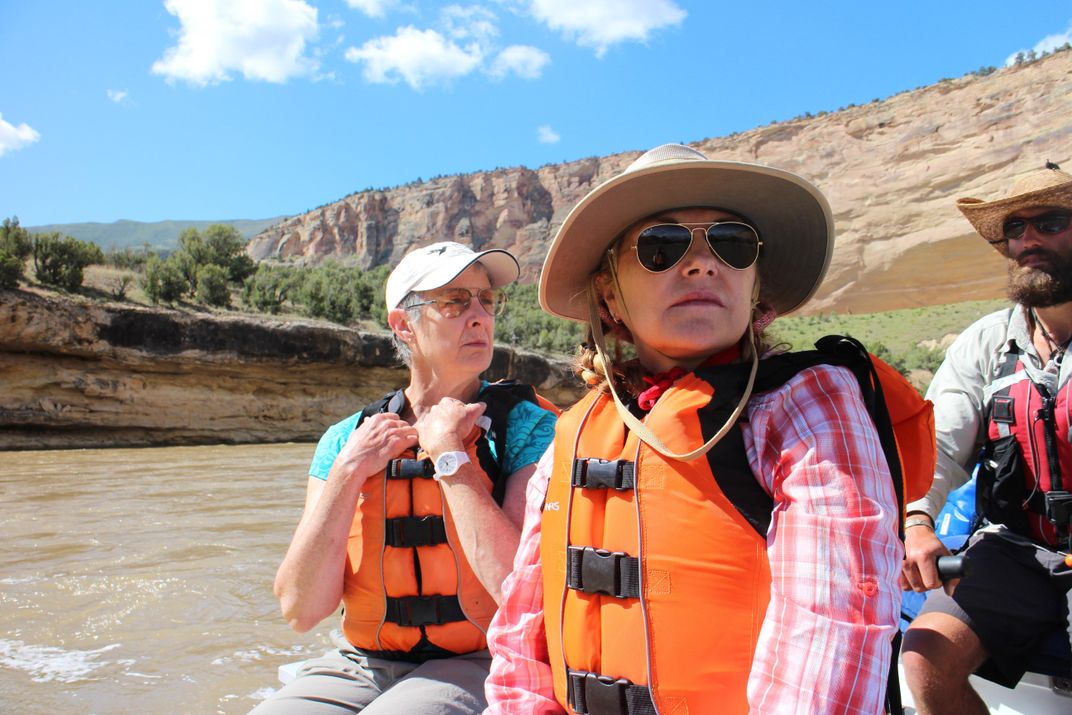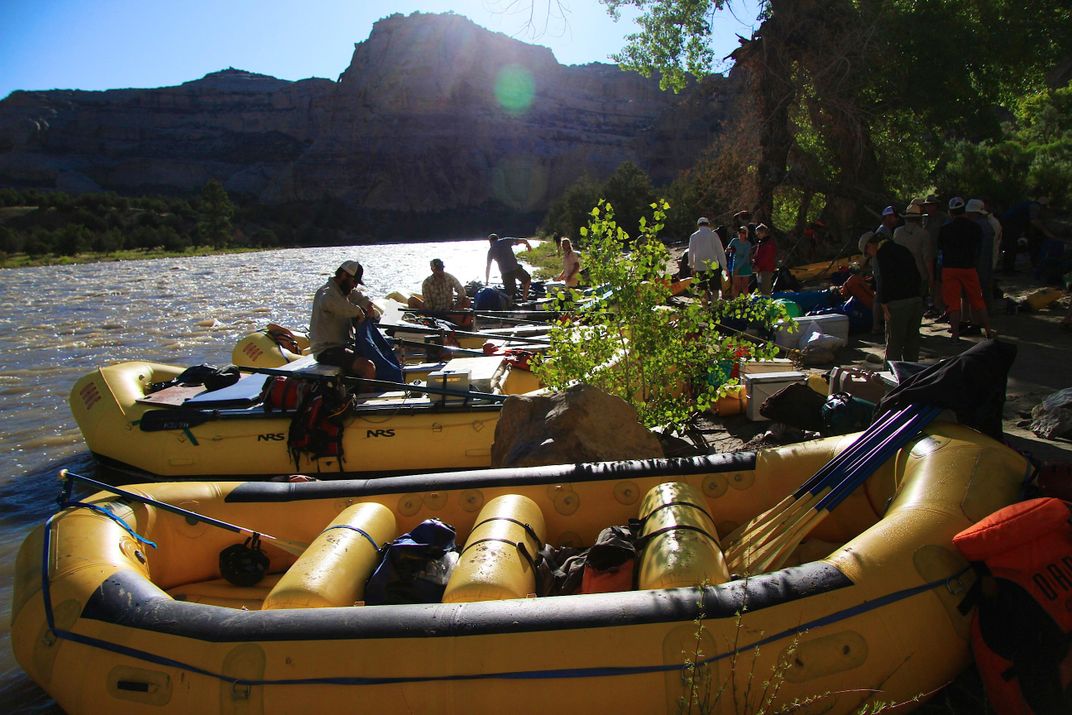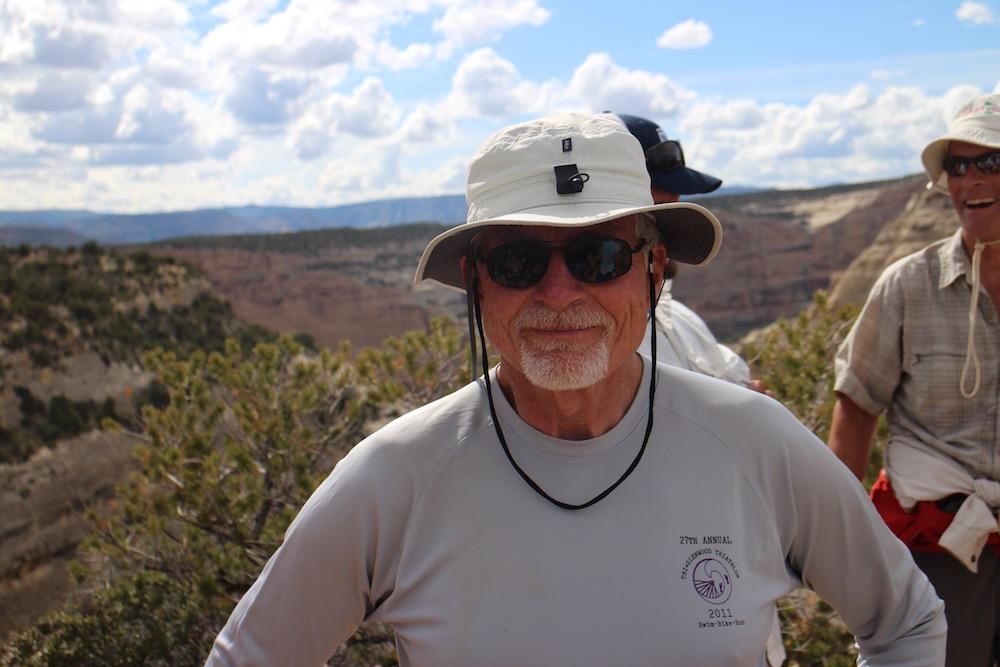Twenty of the West’s Leading Water Managers Raft Colorado’s Yampa River
In a historic drought, a group of decision makers take to the water to discuss the future of rivers
/https://tf-cmsv2-smithsonianmag-media.s3.amazonaws.com/filer/5e/57/5e579eba-23e8-45cb-b9aa-32670943e8c7/img_0221.jpg)
In the morning, there was a bathtub ring around the river, a wet slice of canyon wall just above the waterline. Flows on the Yampa River, the last major undammed tributary of the Colorado, were starting to drop.
We had come to the canyon that the Yampa carved through ancient Weber sandstone on a raft trip, to talk about the future of wild rivers, and rivers in general. Advocacy groups Friends of the Yampa and American Rivers decided that the best way to talk about water issues was on the water. So they pulled together 20 people who have been making decisions about water in Colorado, and in the West, for the past 30 years—the head of Denver Water, former Deputy Secretaries of the Interior, ranchers, power plant managers and environmentalists—and a few journalists like myself. They tempted them with the idea of running an untapped river, and then stuck everyone in boats for five days so they had to talk to each other.
The Yampa flows from the high country near Routt National Forest, past power plants and ranchlands, into Dinosaur National Monument where it joins the Green River at Echo Park. It hits the main stem of the Colorado just over the border in Utah. Even though it’s not dammed anywhere, it’s used by almost all the major groups who depend on river flows: farms, fish, cities, industry, recreation and power. The coal-fired Craig Power Plant is its major consumptive user. Endangered fish like the Colorado pikeminnow depend on its flow. Along the way it irrigates pasture lands and provides flows for kayakers. And, if it continues to run free—hence the flow-dependent bathtub ring—it can be a model for fish habitat and smart agricultural use.
Water managers, however, are constantly pushing for the river to be spread a little thinner, and there’s the looming threat that Denver, to the east, could divert water its way. There have been proposals in the past for a transbasin diversion, a project to pump the river to the other side of the Continental Divide and growing cities—like Colorado Springs, and the sprawling Denver suburbs—on the eastern slope. Eighty percent of Colorado's water, including the Yampa, is on the west side of the divide, while 80 percent of the state’s population lives in the east. Around the campfire, Denver Water CEO, Jim Lochhead, said he has no plans to divert the Yampa, now or ever, but Denver’s population is projected to double by 2050 and residents in the growing suburbs are worried about their water supply.
This spring, late rains bumped Colorado back up to almost 100 percent of it’s average yearly precipitation, and the fields and hills above the upper reaches of the Yampa were glowing green, as the group traveled 71 miles from Deerlodge Park in Colorado to Vernal, Utah. But that vibrancy is deceiving. The Colorado River Basin is 16 years into a drought. Downstream, California is making the largest water cutbacks on record, and Lake Mead is dropping toward 1,075 feet of water, a level it's never hit before and that triggers the first-ever mandatory water cuts in the Colorado River Basin.
"No homeowner is going to be unable to take a shower,” says Colorado water lawyer Melinda Kassen, about Mead’s encroaching cutoffs. “But it calls the question of what happens when we start curtailing water.”

On the river, as we floated through the folded geology of the canyon and stopped to scout rapids, we talked about those questions. At night, people pulled up chairs around the fire, cracked beers and tried to explain their priorities. We talked about risk management and sharing the burden of drought. The most heated topic was transmountain diversions of water across the Continental Divide, and how to avoid them.
The Yampa, and with it the state of Colorado, is a microcosm of river management. Colorado has to send almost half of the water that falls in the state downstream. To complicate things, the state's water law is legally layered and hard to change. This spring, a bill that would allow Colorado residents to collect rainwater failed to pass, because it was argued that it could injure downstream water rights.
“It’s just like balancing a checkbook,” says Eric Kuhn, the general manager of the Colorado River Water Conservation District. “Based on the last 16 years, nature has provided a flow of about 13 million acre feet of water at Lee’s Ferry [just below Glen Canyon Dam], and our estimate is that we’re using about 15 million. Since then, we’ve overused the system by 30 to 32 million acre feet, which we know because we’ve drawn down storage by that amount. We started with 50 million in the bank, now we have about 18. The system is heading for zero.”
The Colorado River Compact, which was signed in 1922, is the framework for water in the West. It outlines how many acre feet each state in the Colorado River Basin can take, but it also allocates more water than actually exists. It was signed in the wettest period in recent history, which means the numbers aren’t based on current reality. Until now, no city or river district has had to draw on their full allotted flow because there has been adequate storage, but now reservoirs are depleted, this whole century has been dry, and with Mead hitting 1,075, the first mandated warning bells are going off. Increasing demand from ever-growing western cities plus decreased supply from a multi-year drought and evaporation in rising temperatures means that the already over-allocated rivers of the West will be checked even more.
Future plans for living within our water means have to comply with both decades-old ideas of property rights and present-day use patterns and population growth. And they have to do it with less water than was originally in the budget, which makes for a lot to talk about around a campfire.

Water rights are also based on a use-it-or-lose-it principle of beneficial use. In theory, or maybe in the 1920s, that sounds good, because it implies that if you're using a lot you must need a lot. But now it means that senior rights holders—corporations, irrigation districts, water departments and others with earlier and higher priority rights that get their share of water first—are unlikely to use less water than they’re allotted, for fear they’ll never get it back. It makes conservation unappealing, because by using less, you could be selling your security blanket down the river.
“Everybody is trying to preserve dreams from the past,” says Jay Gallagher, from the Colorado Water Conservation Board, after the boats were pulled up on the beach one day. “They want security for today and something left over for tomorrow. That's the root of the emotion around water, the fear of losing it.”
That’s particularly true on the Yampa, which feels like the last of a dying breed. The Colorado itself has been so allocated that it no longer flows to the Pacific, and other western rivers, like the Dolores, in southern Colorado, are considered dead, because only a trickle flows past the dam. The Yampa is the only one that has remained untouched despite proposals to siphon off or dam up its flow.
Conservation across all facets of the water system, from farming to lawn watering, could stanch the bleeding, but it’s tricky to ask people who have a legal right to a certain amount of water to give it up. To change both perspective and use patterns, you have to make the greater good also good for the individual. Kuhn says that basically comes down to money—you have to make it financially smart for water users to conserve.
On the river, as the flow ebbed and rose, there was talk of how to work within the system to make conservation appealing and mutually beneficial. Even dinner-time burgers—grass-fed, locally grown—raised commentary. Grass, including grazing, lawns and hay fields, is the biggest water hog in Colorado, and across a lot of the West, so cutting it back could save a huge amount of water. Geoff Blakeslee, a longtime rancher who was on the trip, says the Cattleman’s Association is having trouble persuading its members to conserve.
It’s also hard to convince people to plan for a future they can’t be sure of. A few wet years in a row could bump the reservoirs back up, which is how the system has sustained itself until now. But we can’t assume that will come. And with rising temperatures from global warming, it might not be enough.

In mid July, the second draft of the first-ever Colorado Water Plan is due for comments, and the final is scheduled to be done by December. There’s never been a state-wide plan before; this one has been in the works for a decade, since the 2002 drought, and will draw on plans from nine river districts in the state so that, hopefully, no one feels shorted in an unpredictable future.
Kuhn is trying to outline the clearest ways to make conservation financially appealing. There is talk of setting up a water market, where willing sellers and buyers can trade water rights. "Those plans are moving at a snail’s pace, but the conversations are happening," he says. People on the trip are also working together on smaller, creative projects. Blakeslee is fallowing parts of the ranch he manages to try to conserve, while American Rivers is working with ranchers to create manmade riffles—small rapids where fish can find food—on streams to build trout habitats without diverting any water.
On the Yampa, despite the disparate intentions, there was more teamwork than infighting. “Overall the average amount of water we recieve each year is still below our needs,” Kuhn says. “What we need to figure out how to do is live within our means.”
One evening on the banks of the river, Matt Rice, the director of American Rivers’ Colorado River Basin Program, brought out a bottle of beer he’d been saving. “It’s called ‘Collaboration Not Litigation,’” he said. “And I think we should all have some.”
/https://tf-cmsv2-smithsonianmag-media.s3.amazonaws.com/accounts/headshot/DSC_0196_2.JPG)
/https://tf-cmsv2-smithsonianmag-media.s3.amazonaws.com/accounts/headshot/DSC_0196_2.JPG)